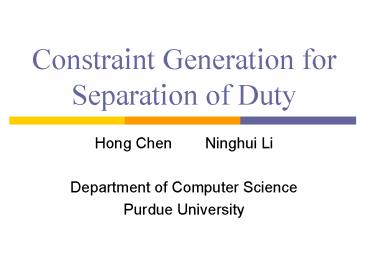Constraint Generation for Separation of Duty - PowerPoint PPT Presentation
1 / 22
Title:
Constraint Generation for Separation of Duty
Description:
SSoD policies often enforced by Statically Mutually Exclusive Role ... Enforce ... singleton sets of SMER constraints that minimally enforce the policies ... – PowerPoint PPT presentation
Number of Views:71
Avg rating:3.0/5.0
Title: Constraint Generation for Separation of Duty
1
Constraint Generation for Separation of Duty
- Hong Chen Ninghui Li
- Department of Computer Science
- Purdue University
2
Overview
- Separation of Duty (SoD) is important in access
control - In Role-Based Access Control (RBAC)
- SoD objectives encoded by Static Separation of
Duty (SSoD) policies - SSoD policies often enforced by Statically
Mutually Exclusive Role (SMER) constraints - Study how to generate SMER constraints that
- Enforce a set of SSoD policies
- Are nice with respect to the role hierarchy
- Are the best choices
3
Outline
- Problem Definition
- Our Solution
4
Role-Based Access Control
- Components
- U (user set), P (permission set), R (roles set)
- PA ? P x R (permission assignment)
- RH ? R x R (role hierarchy)
- UA ? U x R (user assignment)
5
Static Separation of Duty Policy
- SSoD
- SSoD policy
- Any users should not acquire all
permissions in - an RBAC state is safe
wrt. SSoD policy - Example
- RBAC state is safewrt. the policy
6
Statically Mutual Exclusive Roles
- SMER
- t-m SMER constraint
- No single user can be a member of or more
roles in an RBAC state
satisfies a SMER constraint - Example
- RBAC state satisfiesthe constraint
7
Use SMER to Enforce SSoD
- Results in On mutually-exclusive roles and
separation of duty Li, Bizri, and Tripunitara,
CCS 2004 - To check if an RBAC state is safe wrt. a set of
SSoD policies is coNP-Complete - To check if an RBAC state satisfies a set of SMER
constraints is in P - To verify whether a given set of SMER constraints
enforce a set of SSoD policies is coNP-Complete
Generating SMER constraints from SSoD policies
seems promising
8
Generation Problem
- How to generate a set of SMER constraints to
enforce an SSoD policy?
?
Enforce
9
Restrictiveness
- One constraint can be more restrictive than
another Ex c1 is more restrictive than c2 - We prefer less restrictive constraints
10
Minimal Enforcement
Space of RBAC states
Unsafe RBAC states
11
Current Results Li et al. 04
- An algorithm to generate singleton sets of SMER
constraints that minimally enforce the policies
12
Problem 1
- No consideration of interaction with the role
hierarchy - Compatibility
- Implementation compatible enforcement
13
Problem 2
- Singleton constraints are not enough
14
Our Objectives
- Generate sets of constraints that
- enforce a given set of SSoD policies
- are compatible with the existing role hierarchy
- are not more restrictive than any other
constraint sets that also satisfy 1 2
15
Outline
- Problem Definition
- Our Solution
16
Our Contributions
- Define the notion that a set C of SMER
constraints implements a set E of SSoD policies - C enforces E and C is compatible with E
- Show how to check whether C is compatible with E
- Show that size-k1 SMER adds additional
expressive power over size-k SMER - Show how to compare the restrictiveness of
constraint sets - Give two algorithms for generating constraint sets
17
Constraint Generation
- An algorithm to generate all sets of SMER
constraints that minimally implement a set of
SSoD policies - Algorithm
- C ?
- Repeatedly
- Find an user assignment UA which satisfies C but
is not safe wrt. E - Create a constraint c s.t. UA violates c (2 ways)
- Add c to C
- Until C implements E
- Return C
18
Example
Constraint set
19
Summary
- Enforce (implement) SSoD policies by SMER
constraints - Two problems in current solution
- Constraints not compatible with role hierarchy
- Only generate singleton constraints
- New algorithms
- Generate compatible constraints
- Generate all constraints that minimally implement
the policies
20
- Thank you ?
- Questions?
21
Testcase 1
22
Testcase 2































